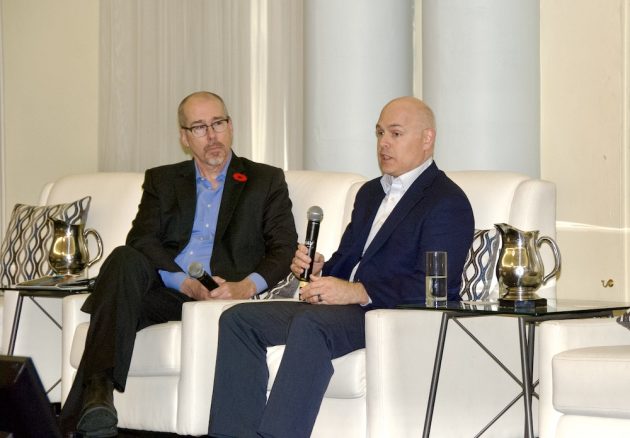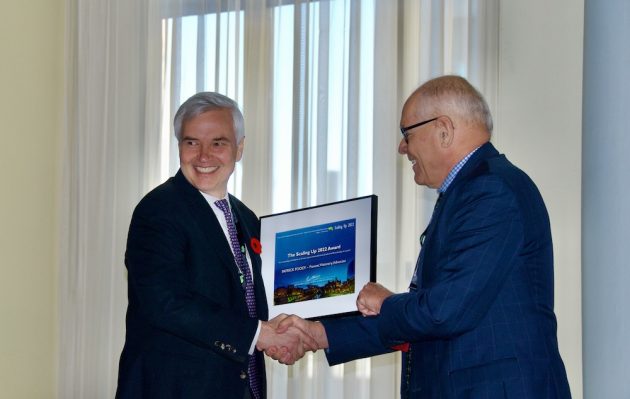
Industrial bioeconomy players share optimism at Scaling Up
November 15, 2022
By
Maria Church
Ottawa conference heard from a spectrum of bioeconomy stakeholders, from policy makers to financiers to those putting steel in the ground.
 Scaling Up was back in person last week in Ottawa. Photos: Annex Business Media.
Scaling Up was back in person last week in Ottawa. Photos: Annex Business Media. Momentum from promising policy in the U.S. and optimism for Canada to follow suit made the Scaling Up conference on the industrial bioeconomy an energetic affair in Ottawa last week.
Stakeholders from policy makers to financiers to bioeconomy players took to the stage to discuss progress and strategies to move Canada’s bioenergy and bioproducts industry forward, “further and faster.”
Policy progress
Policy talk dominated discussion during the three-day conference. As David Dodds with Dodds & Associates LLC put it: “Necessity is the mother of invention, but policy is the mother of investments.”
Speakers lauded the U.S. Inflation Reduction Act (IRA) as a game-changer to incentivize bio-projects in the U.S., and many called on Canada to replicate or improve on the legislation to incent domestic production of bio-based products. One commenter urged fast policy action to ensure Canadian biomass resources are made into high-value products here rather than exported to fuel the “bio-revolution” unfolding globally.
Wal van Lierop, founding partner of Chrysalix Venture Capital, called it a “dog’s breakfast” of opportunity in the global bioeconomy. He suggested Canada create a bioeconomy institute to take an international lead. “We have a Pandora’s Box of the bioeconomy opportunity and someone needs to open it, and someone needs to regulate it,” he said.
When it comes to the IRA, the question on everyone’s mind in the bioeconomy is, “how is it going to affect their projects,” said Chris Hessler, managing partner with AJW Inc. “The answer is simple: It’s complicated. And it depends,” he said.
Biomass is explicitly included in many tax provisions in the IRA, Hessler said, and, for the first time, there will be a ranging tax structure. The baseline is an end product, and further tax breaks are available for things such as domestic production and infrastructure improvements.
In her recap of the swatch of Canadian policies incentivising the low-carbon energy transition, Rachel Samson, vice-president of research for the Institute for Research on Public Policy, said the bioeconomy is an ideal opportunity to help communities that are vulnerable to that transition, such as rural and remote communities.

From left, Jeff Passmore, Kate Bigney and Glenn Hargrove.
Responding to Scaling Up organizer Jeff Passmore’s question about the development of a national bioeconomy strategy, Glenn Hargrove, assistant deputy minister for the Canadian Forest Service, and Kate Bigney with Agriculture and Agri-Food Canada, said they were open to the idea.
Hargrove said many conversations have happened behind the scenes that would make up the elements of a national strategy, noting a more co-ordinated approach would help bring certainty to private investment.
SAF bullet
Sustainable aviation fuel (SAF) was a buzzword for the two-day conference, with several stakeholders on the stage, including LanzaJet and Shell.
Simon Paradis, Shell’s energy transition program manager, spoke about the business case for SAF: “The decarbonization of the aviation sector will be a SAF story,” he said. “It’s the only currently viable way to decarbonize the aviation sector, especially on long-haul flights.”
Domestic SAF manufacturing is an opportunity to decarbonize global aviation, Paradis said, pointing to the Canadian Council for Sustainable Aviation Fuels (C-SAF) as a step forward. C-SAF launched earlier this year with a mission of accelerating SAF deployment in Canada.

From left, Chris Hessler, managing partner with AJW Inc., interviews LanzaTech’s vice-president of public policy, Tom Dower.
In a Q&A with Hessler, LanzaTech’s vice-president of public policy, Tom Dower, said the company is “bullish” about SAF and considers it an important component in their portfolio of hard-to-abate sectors. “We are very invested,” he said.
LanzaTech formed LanzaJet in 2020 to focus on SAF and renewable diesel, and has committed to scaling up production of SAF through its alcohol-to-jet technology.
Projects we’re watching
Scaling Up put the spotlight on several Canadian bioeconomy projects in the works. Here’s a snapshot of some we’re watching with interest:
OMNI Conversion Technologies based in Ottawa rose from the ashes of Plasco Conversion Technologies with a new business model: doing what they know best – turning a hard-to-treat waste product into syngas – and partnering on the rest.
Marc Bacon, president and COO of OMNI, said when he brought the company out of receivership in 2015, they took a hard at what went wrong the first time. The conclusion was to abandon the build-own-operate model and bring in partners who excel at other aspects of getting a product to market, such as facility fabrication and end-use product experts. “That has paid off in the last year,” Bacon said. OMNI recently announced a partnership with ABB.

From left, Marc Bacon, president and COO of OMNI Conversion Technologies, and Ziyad Rahme, vice-president of investments for Sustainable Development Technology Canada.
In his talk on the critical importance of forest management in Canada to combat growing forest carbon emissions from pests and wildfire, Torchlight Bioresources’ Jamie Stephen teased a new project called Rocky Mountain Carbon. The project is a partnership between Torchlight, forest products heavyweight West Fraser, and carbon capture and storage (CCS) developer Vault 44.01. No details yet, but we are expecting to hear more soon.
Scaling Up’s provincial spotlight this year was Alberta. Two companies took to the stage to introduce their bio-offerings: Canary Biofuels and Canadian Rockies Hemp Corp.
Founded last year and based in Calgary, Canary Biofuels’ facility in Lethbridge is the first second-generation biodiesel plant in Alberta with a capacity of producing 20 million gallons of biodiesel and nine million pounds of glycerin from agricultural waste. The company recently acquired another facility in Stockton, Calif., that can produce 10 million gallons of biodiesel from mixed waste feedstock and 18 million pounds per year of crude glycerin.
Canadian Rockies Hemp Corp., based in Bruderheim, Alta., northeast of Edmonton, is pioneering the harvesting and processing of hemp for bioproducts. The company’s processing facility has a capacity of 50,000 tonnes of fibre and 110,000 tonnes of hurd. A planned upgrading facility will allow the company to produce pellets, pallets, and other bioproducts for industry.

From left, Mehr Nikko, senior manager of clean technology for Alberta Innovates, Rob Skilnick, CFO for Canary Biofuels, Aaron Barr, CEO of Canadian Rockies Hemp Corp., and Sheila Harrison, vice-president of policy for the Alberta Forest Products Association.
A final project we are watching closing is Hydrogen Naturally – a start-up partnership between forestry player Peak Renewables and CCS player North West Capital Partners. The company plans to produce “bright green hydrogen” at plants in B.C. that will turn wood waste into hydrogen through gasification and downstream separation, combined with carbon sequestration.
“We’re trying to preserve the carbon attributes of the tree in the hydrogen we produce,” Hydrogen Naturally’s executive chairman Ian MacGregor told the Scaling Up crowd.
Passmore introduce a new award at this year’s conference to recognize outstanding contribution to the commercialization of industrial biotechnology in Canada. The award went to Iogen’s Patrick Foody.

This article is part of Biofuels Week 2023. To read more articles on biofuels, click here.
Print this page